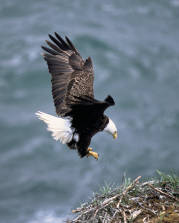There wasn’t a study of the impact on natural gas extraction on bald eagles before operations started in anticline region of the Green River Valley of Wyoming, so a new study will closely examine which habitats bald eagles in the area are using, and which they are not using, says an article in the Jackson Hole News & Guide.
The study is being conducted by Bryan Bedrosian of Craighead Beringia South, a non-profit science and education institute, and Susan Patla of the Wyoming Department of Game and Fish, the article says. According to the Craighead Beringia South website, the Bureau of Land Management is another partner in the study.
The research team has attached a solar-powered, rechargeable GPS/satellite tracking devices to six bald eagles, with the stated goal of tracking 12 bald eagles in total. The study is expected to last six years.
Details of the trapping method are described in the Jackson Hole News & Guide article. Read it here.
More details about the study are available on the Craighead Beringia South website. Here. (Includes a slideshow.)
See where the eagles with transmitters are flying, here.

